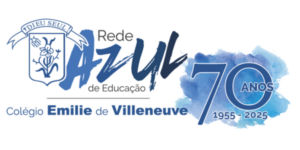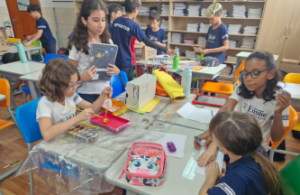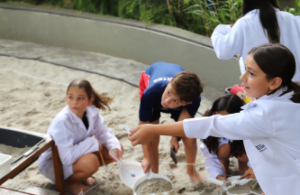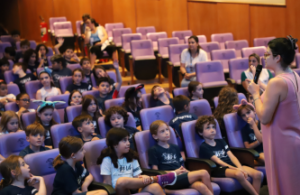Research shows that questioning through powerful questions has a positive impact on learning. When students try to answer a question, they begin to build new ideas, apply knowledge, assimilate new information and demonstrate understanding as part of an investigative process.
Our first graders had a very interesting experience recently: they made a rainbow experiment using a plastic cup, water, colored markers and a sheet of paper towel.
When asked about what predictions could be made in this experiment, students suggested a different one: what if we color one side of the paper using rainbow colors and place both paper ends into two cups with water? Would the colors travel from one cup to the other through the paper towel?
The expected result didn’t happen, so the kids decided to wait until the next day to check if the colors would “travel” to the other cup. On the following day they found out that nothing happened.
Later, students have performed the experiment that was previously planned, in which they should color both ends of the paper and immerse it in two cups with water.
Some of their hypotheses were:
“Are we going to have shiny water?”
“Is it going to shine in the dark?”
“I think the colors are going to meet in the middle of the paper.”
“I believe the water is going to rise when we immerse the paper in it.”
In the end, children concluded that the colors have met in the middle of the paper and within time, the color of the water in the cups has changed. They registered their findings, showing how significant this experience was to them, revealing a high level of engagement throughout the investigative process.
*****
O experimento com as cores do arco-íris
Pesquisas indicam que o questionamento por meio de perguntas potentes tem um impacto positivo na aprendizagem. Quando os alunos tentam responder a uma pergunta, eles começam a construir novas ideias, aplicar conhecimentos, assimilar novas informações e demonstrar compreensão como parte de um processo investigativo.
Nossos estudantes do Grade 1 tiveram uma experiência muito interessante recentemente: eles fizeram um experimento de arco-íris usando um copo de plástico, água, canetinhas coloridas e uma folha de papel-toalha.
Quando perguntados sobre quais previsões poderiam ser feitas neste experimento, os alunos sugeriram uma proposta diferente: e se colorirmos um lado do papel usando cores do arco-íris e colocarmos as duas pontas do papel em dois copos com água? As cores passariam de um copo para o outro através do papel-toalha?
O resultado esperado não aconteceu, então as crianças decidiram esperar até o dia seguinte para verificar se as cores iriam “viajar” para o outro copo. No dia seguinte, descobriram que nada aconteceu.
Posteriormente, os alunos realizaram o experimento previamente planejado, no qual deveriam colorir as duas extremidades do papel e mergulhá-lo em dois copos com água.
Algumas de suas hipóteses foram:
“Vamos ter água brilhante?”
“Vai brilhar no escuro?”
“Acho que as cores vão se encontrar no meio do papel.”
“Acredito que a água vai subir quando mergulharmos o papel nela.”
Por fim, as crianças concluíram que as cores se encontraram no meio do papel e com o tempo a cor da água nos copos mudou. Eles registraram suas descobertas, mostrando o quão significativa essa experiência foi para eles, revelando um alto nível de engajamento ao longo do processo investigativo.
Grade 1 Teacher: Ms Narelle Jardim
Assistant Teacher: Ms Mariana Alves











